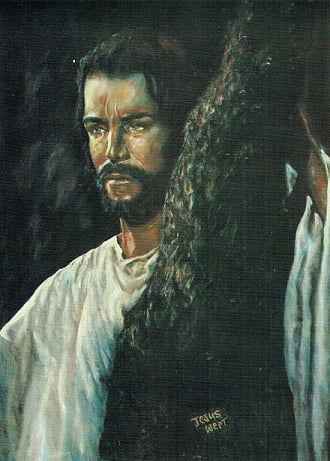Nothing is more important than The Cross, on which hung the Savior of the world. In today’s busy world we can easily be distracted from this Truth; and then, if we are lucky, He will gently place something in our path as a reminder.
Recently my mother has begun the process of separating her belongings among her children. This usually means taking one of us aside, asking if we would like to see something, and if we answer affirmatively she will grab our hand and show us the item. If we express anything resembling joy, or if we remark that it is indeed lovely, the item is placed in our hands and we are told (ordered) to put it in our car.
Arguing is useless. She wants items removed NOW, and complains over those who say "Sure, but I will come back for it later." Over the past few months I have become more judicious in my assessment of certain objects. No need to have more than three iron pots, my husband says.
And then one day she put the art book in my hands.
She had asked me to follow her up the staircase to her loft where a collection of books resided; these were books she had collected over the years from thrift shops, antique stores, and her many travels. The print in one particular old art book was too small for her eyes (she suffers from macular degeneration) and she did not know what to do with this large heavy anthology. Stroking the cover, she told me she had spent many quiet hours looking through it over the years.
As I opened this art book copies of a painting fell out: Jesus Wept, by Marion S. Wittenhagen.
 "Jesus Wept" by Marion Wittenhagen 1970, photographed by the author.
"Jesus Wept" by Marion Wittenhagen 1970, photographed by the author.
Nothing prepared me for the beauty of His Face. Pain, agony, strength and total compassion – all shone through the print. There were also copies of a letter written by the artist describing her thoughts on her painting. As she stated: “I was forced to use my own anguish to depict the tears and the sorrows which I felt Jesus suffered during His last hour in the garden.”
I have spent many hours since trying to find out more about Marion. What did she mean when she wrote about using her own anguish? Marion painted this in the spring of 1970, and was mentioned in a truly moving piece by Professor Emeritus Donald Burt (Villanova University) called Hospice: Reflections on a Dying Life. As admonished by Professor Burt in this moving piece:
“You don't need to be as "smart" as Augustine to bring Christ to your world. Indeed, you do not need to be particularly strong. As I type these words, I see before me a picture of a painting done by an artist friend of mine, Marion Wittenhagen. It is a head of Christ as he looked just after he had heard the terrible words of Pilate:
"Nothing more can be done!”
Marion had had an unsuccessful surgery on her back and was in constant pain. Her doctors had said there was nothing they could do to relieve the pain because she was not ‘"terminal." She painted Jesus Wept from her bed, and when she couldn’t get the eyes "just right," she dragged her easel into the bathroom, propped it up and painted her own eyes. As she wrote on her typewriter:
“If you cover the right side of Jesus’ face with paper you see His power, His strength, See that all-knowing eye…THIS IS THE CHRIST.
Then cover the left side of Jesus’ face: See the compassion, the love the gentleness and mercy. See the sorrow…THIS IS THE MAN OF GOD.”
Finding this print pressed between the pages of a book my mother has loved for many years, and reading about the reflections of both Marion and Professor Burt on life, pain, and dying was a gentle reminder to stop and remember that life is truly temporal. Christ bore it all for us, in the garden and on the Cross. He bore it so we would be saved. He bore it out of Love.
We can do no less as we live our life.
I have my mother’s art book now. It went directly into my car. She didn’t even have to ask me twice.
Copyight 2016 Carol S Bannon
About the Author

Carol Sbordon Bannon
Carol Bannon currently lives in Massachusetts with her husband. She is a wife, mother, grandmother to seven, substitute teacher, and an active supporter of the Down Syndrome Society of Rhode Island (DSSRI). Carol is the author of Handshake from Heaven and Our Family’s Christmas Elf. She and her husband love to spend time boating on Cape Cod and traveling to new harbors.


.png?width=1806&height=731&name=CatholicMom_hcfm_logo1_pos_871c_2728c%20(002).png)
Comments